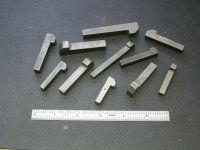You have what are sometimes called "gibbed keys", or tapered keys. They are used to lock a hub on a shaft. I believe the standard taper to them was 1/4" to the foot.
We had to put a flyhweel on a shaft of the horizontal steam engine at Hanford Mills. The engine had last run in a quarry in Vermont in the 1930's, and had been run into the ground. The flywheel was supposed to be held by a tapered key to lock it onto the cranksahft, No key was used, and the clamping power of the setscrews was evidently enough ! This on a 3 1/2" diameter shaft, sloppy fit in the flywheel hub.
I took measurements not knowing what I had to work with in the way of a taper. The crankshaft had the straight keyway, flywheel had the taper. I think the key was about 9" long, and it was a stepped key as well as having the taper (someone probably put a flywheel from something else onto that engine). When I ran my numbers for the taper, based on my field measurements, I had 1/4" to the foot, which corresponded with my Machinery's Handbook data for this type key.
I did make the gibbed or trussed head, as there is no way otherwise to get the key pulled out, should it be necessart (no way to get at the small end of the key to drive it back).
I could see the wisdom in the use of the tapered key. It would prevent the flywheel from "walking off the shaft". If used with a belt that might run slightly off, or just from eccentricity or shaft whip, any of these could walk a flyhweel or pulley off a shaft. The tapered key wedges fast and there is no moving the hub on the shaft. I think I would have to jack the hub away from the key to get the key broken loose on the Hanford Mills Engine. I do not think there is any way that putting a pinch bar under that gibbed head would loosen that key. We are all quite happy eith the result of using the tapered key as wre know the flywheel is on the crankshaft to stay. With the public coming into the engine room and standing near the running engine, we do not need a flywheel walking off the shaft.
Mike Korol, the Skinner Engine erector told me of a tale of a flywheel walking off a shaft on a smaller engine. This was a Troy vertical steam engine driving an induced draft fan in a NYC Hospital (Harlem Hospital, possibly). The ID fan engine sat up on a platform, and ran pretty much "out of sight out of mind". One day, the engine launched it's flywheel. It just worked off the shaft, and took a good trajectory. The flywheel made it out of the boiler room via an opened door, and rolled accross the street and slammed into a masonry building wall, doing some damage. At the powerplant where I work, we had a Kellog air compressor in the plant garage. A mechanic had just overhauled the compressor and put the flyhweel back on. He claims to have "reefed the snot" out of the pinch bolt in the hub of the flyhweel. He fired up the compressor and before it made it to full operating speed, and despite a multiple vee belt drive, it launched the flyhweel. The flywheel came off the compressor crankshaft, hit a concrete block wall a short distance away, and made a nice hole in the masonry.
Point of both stories: a tapered key would have prevented both incidents. The compressor had a straight key and pinch bolt. I tend to believe the mechanic who worked on the compressor was one of those OCD types who also thinks he knows more than he really does and it does not translate into his hands. His idea of reefing the snot out of a pinch bolt, and the next guy's were likely vastly different. A tapered key would have probably saved the situation.
I think with the advent of "taperlock" bushings, the need for tapered or gibbed keys as shown in this thread kind of dried up. The tapered key requires a tapered keyway, not so easy to cut as a straight keyway. Taperlock bushings make a better job in terms of holding power and concentricity, and are easier to get off (or at least are supposed to be), so the tapered keys fell out of disuse.
Main use is on heavy flyhweels on things like old engines and rock crushers or other heavy, slow speed machinery. Stuff like some of the hit-n-miss engines or other old engines would be likely places this type key would turn up (pardon the pun).
Joe Michaels



 . I took one out of a sheave a couple weeks ago by welding a piece of all-thread to the end of a key to use as a slide hammer after wedging under the head failed.
. I took one out of a sheave a couple weeks ago by welding a piece of all-thread to the end of a key to use as a slide hammer after wedging under the head failed.